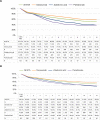Prevalence of bone metastases and bone-targeting agent use among solid tumor patients in the United States
- PMID: 26229504
- PMCID: PMC4514316
- DOI: 10.2147/CLEP.S85496
Prevalence of bone metastases and bone-targeting agent use among solid tumor patients in the United States
Abstract
Purpose: Patients with bone metastases are at an increased risk of experiencing morbidity due to bone complications, and bone-targeting agents (BTA) are indicated for the prevention of these complications. Population-based estimates of the prevalence of bone metastases associated with solid tumors, and current treatment patterns for these patients, are limited. This study was undertaken to estimate the prevalence of bone metastases from solid tumors and to describe recent trends in the use of BTA in the US.
Methods: We estimated the prevalence of bone metastases in the US in 2012 using data from Medicare fee-for-service and PharMetrics Plus, a large commercial claims database. We evaluated the proportion of patients with bone metastases who were treated with BTA in 2012, timing of initiation of BTA relative to bone metastasis diagnosis, and persistence on BTA, overall and by primary tumor type and treatment.
Results: There were ~330,000 (168,063 Medicare fee-for-service; 162,239 other) patients aged ≥18 years living with solid tumors and bone metastases in 2012. BTA were used by 43% (Commercial) to 47% (Medicare) of patients in 2012, with the greatest use among breast cancer patients. Over half (Medicare: 57%; Commercial: 53%) of BTA-treated patients initiated BTA after experiencing a bone complication.
Conclusion: Of the estimated 330,000 solid tumor patients living with bone metastases in the US in 2012, many may have received less than optimal care to prevent bone complications during the calendar year.
Keywords: bone metastasis; prevalence; solid tumor.
Figures




Similar articles
-
Longitudinal patterns of bone-targeted agent use among patients with solid tumors and bone metastases in the United States.Support Care Cancer. 2017 Jun;25(6):1845-1851. doi: 10.1007/s00520-017-3583-1. Epub 2017 Jan 24. Support Care Cancer. 2017. PMID: 28120114 Free PMC article.
-
Quality of life and pain in patients with metastatic bone disease from solid tumors treated with bone-targeted agents- a real-world cross-sectional study from Switzerland (SAKK 95/16).BMC Cancer. 2021 Feb 19;21(1):182. doi: 10.1186/s12885-021-07903-8. BMC Cancer. 2021. PMID: 33607966 Free PMC article.
-
Patterns of care for patients with metastatic bone disease in solid tumors: A cross-sectional study from Switzerland (SAKK 95/16).J Bone Oncol. 2019 Dec 16;21:100273. doi: 10.1016/j.jbo.2019.100273. eCollection 2020 Apr. J Bone Oncol. 2019. PMID: 31970055 Free PMC article.
-
Denosumab for the prevention of skeletal-related events in patients with bone metastasis from solid tumor.Pharmacotherapy. 2012 Mar;32(3):274-84. doi: 10.1002/j.1875-9114.2011.01092.x. Epub 2012 Feb 13. Pharmacotherapy. 2012. PMID: 22392458 Review.
-
Repaglinide : a pharmacoeconomic review of its use in type 2 diabetes mellitus.Pharmacoeconomics. 2004;22(6):389-411. doi: 10.2165/00019053-200422060-00005. Pharmacoeconomics. 2004. PMID: 15099124 Review.
Cited by
-
Mirels Scores in Patients Undergoing Prophylactic Stabilization for Femoral Metastatic Bone Disease in the Veterans Administration Healthcare System.J Am Acad Orthop Surg Glob Res Rev. 2020 Sep;4(9):e20.00141. doi: 10.5435/JAAOSGlobal-D-20-00141. J Am Acad Orthop Surg Glob Res Rev. 2020. PMID: 32890013 Free PMC article.
-
Radiofrequency Ablation Provides Rapid and Durable Pain Relief for the Palliative Treatment of Lytic Bone Metastases Independent of Radiation Therapy: Final Results from the OsteoCool Tumor Ablation Post-Market Study.Cardiovasc Intervent Radiol. 2023 May;46(5):600-609. doi: 10.1007/s00270-023-03417-x. Epub 2023 Apr 3. Cardiovasc Intervent Radiol. 2023. PMID: 37012392 Free PMC article.
-
Image-Guided Robotic Radiosurgery for the Treatment of Same Site Spinal Metastasis Recurrences.Front Oncol. 2021 May 28;11:642314. doi: 10.3389/fonc.2021.642314. eCollection 2021. Front Oncol. 2021. PMID: 34123794 Free PMC article.
-
Utilization of agents to prevent skeletal-related events among patients with multiple myeloma: analysis of real-world data.Support Care Cancer. 2018 Mar;26(3):807-812. doi: 10.1007/s00520-017-3892-4. Epub 2017 Oct 23. Support Care Cancer. 2018. PMID: 29063388
-
Longitudinal patterns of bone-targeted agent use among patients with solid tumors and bone metastases in the United States.Support Care Cancer. 2017 Jun;25(6):1845-1851. doi: 10.1007/s00520-017-3583-1. Epub 2017 Jan 24. Support Care Cancer. 2017. PMID: 28120114 Free PMC article.
References
-
- Coleman RE. Bisphosphonates: clinical experience. Oncologist. 2004;9(Suppl 4):14–27. - PubMed
-
- Coleman RE. Metastatic bone disease: clinical features, pathophysiology and treatment strategies. Cancer Treat Rev. 2001;27(3):165–176. - PubMed
-
- Roodman GD. Mechanisms of bone metastasis. N Engl J Med. 2004;350(16):1655–1664. - PubMed
-
- Coleman RE. Clinical features of metastatic bone disease and risk of skeletal morbidity. Clin Cancer Res. 2006;12(20 pt 2):6243s–6249s. - PubMed
-
- Abdulhalim AM, Hussain A, Mullins CD, et al. Burden and timing of first and subsequent skeletal related events (SREs) in United States elderly men with metastatic prostate cancer (MPC) Value Health. 2014;17(3):A72.
LinkOut - more resources
Full Text Sources

